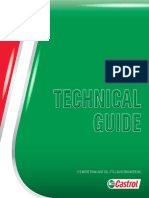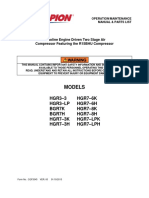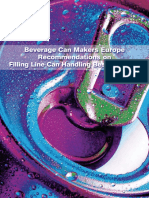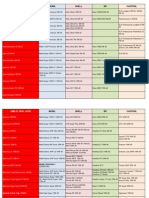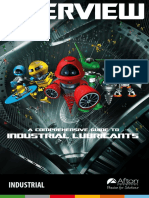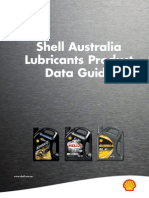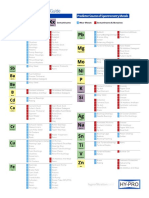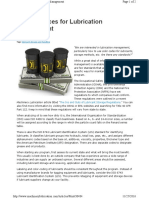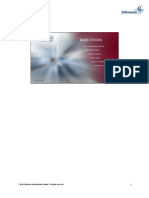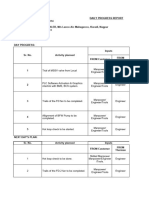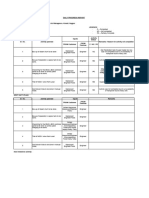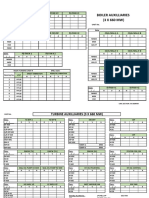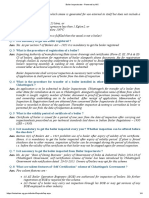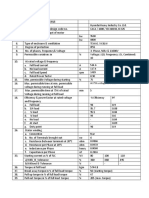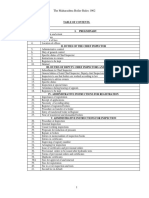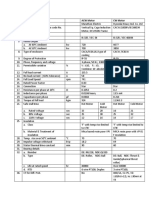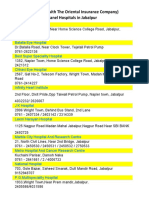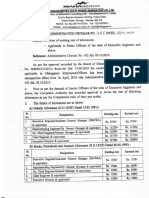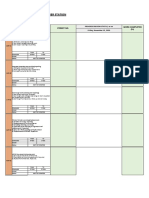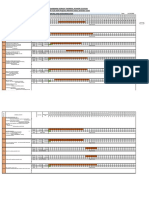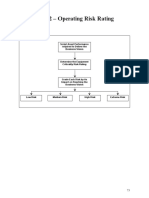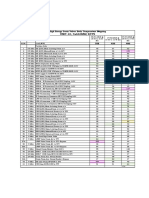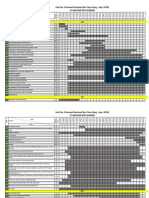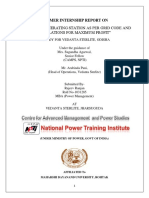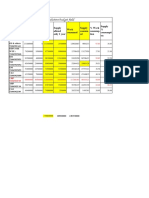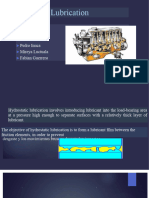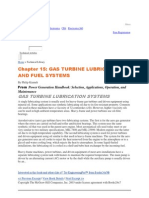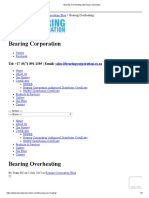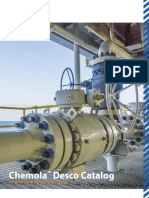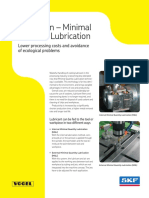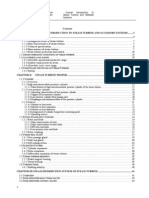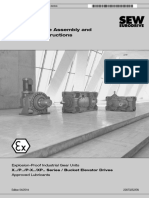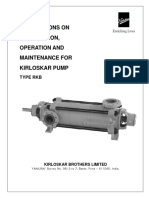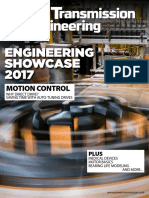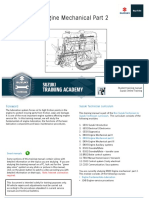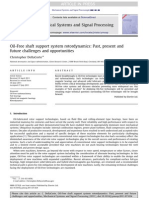Lubricant Condition Monitoring: Why The Lubricants Monitoring
Lubricant Condition Monitoring: Why The Lubricants Monitoring
Uploaded by
rbdubey2020Copyright:
Available Formats
Lubricant Condition Monitoring: Why The Lubricants Monitoring
Lubricant Condition Monitoring: Why The Lubricants Monitoring
Uploaded by
rbdubey2020Original Description:
Original Title
Copyright
Available Formats
Share this document
Did you find this document useful?
Is this content inappropriate?
Copyright:
Available Formats
Lubricant Condition Monitoring: Why The Lubricants Monitoring
Lubricant Condition Monitoring: Why The Lubricants Monitoring
Uploaded by
rbdubey2020Copyright:
Available Formats
GEARS & TRANSMISSIONS Workshop paper XI [ 231 ]
LUBRICANT CONDITION MONITORING
Abel Resina de Almeida, GALP ENERGIA
Why the lubricants monitoring
Lubricants monitoring is an important method on proactive maintenance achievement. It is a tool which
can be used not only to guarantee the lubricant condition to fulfil its function but to accompany the
equipment state evolution as well and identify failure risks, allowing an anticipation, in order to avoid
expensive consequences and prolong the equipment life time.
Considering the lubricant as a machine part, it follows that it also has its maintenance needs. There are
some practical acts of lubricant conservation that can preserve its characteristics and prolong its lifetime.
In this paper it is our intention to make a compilation of basic principles and practical suggestions made
by several experienced authors that will certainly help getting the most out of this tremendous tool.
Integral monitoring
Whenever we talk about lubricant monitoring, the first thing we think on is the oil analysis, when it is
supposed its lifetime is about to finish.
However, if we really want to have a proactive attitude with visible results, it is necessary to go further,
monitoring the lubricant all over its lifetime, since the moment it arrives at the mill until its needed
substitution.
This perspective implies a set of actions, most of them simple, but with great impact in the equipments
functioning conditions.
Handling and Storage
When we are monitoring a lubricant, we need the information to be precise and representative of the oil
and equipment functioning conditions. Only this way we can make the right diagnosis, and act accordingly
with the real situation needs.
To make that possible we need to eliminate all the interfering factors that can influence the results in all
the lubricant’s lifetime.
One of these factors, many times despised, is the lubricant handling and storage. If the lubricant is
contaminated with water or with solid particles, even before being used in the equipment, surely there will
appear inexplicable results in the analysis.
Besides provoking damages in the equipment by altering the lubricant properties or by the presence of
abrasive or reactive contaminants, this kind of situation will lead to erroneous conclusions and to a loss of
time when trying to execute the root cause analysis.
Another danger is the using of the wrong lubricant. In this sense, we ought to be careful not to use
containers with labels of other products, in order to avoid swaps.
Though it is not much frequent, it also might happen that the existent product within the container does
not correspond to the one indicated in the label by the manufacturer. In order to eliminate this possibility,
it is convenient whenever possible to verify by quick and inexpensive methods some key characteristics
of the product, such as its viscosity and colour.
For these reasons, it is very important to guarantee the lubricant correct storage, protecting them from
heat, moister, dust and other contaminants, identifying them correctly. We should also to pay a special
attention to the cleanliness of the tools and the recipients used to transfer the lubricant from its container
to the equipment.
Faculdade de Engenharia da Universidade do Porto, Portugal, 5th June 2003
[ 232 ] paper XI GEARS 2003
Inspection
An inspection plan related to the lubrication ought to pay attention to 3 main factors: the frequency, the
relevant parameters and the collected information managing.
Frequency
Because of the differences in the machines, the inspection frequency should be established having in
account these same differences. Some machines are highly critical and must be inspected daily or in
every shift, while some others should be weekly or monthly. Having in account that simple operations are
involved, it is wise to err on conservative side and make corrections a posteriori if needed. In order to set
up the inspection frequency, let us take into consideration some important issues such as the machine’s
tendency to fail, its impact on the production as well as time, cost and difficulty to restore it upon failure.
Parameters to observe
When establishing an inspection routine, one of the most important tasks is to define which are the
parameters we want to register. Among so many variables it is necessary to determine which are the
relevant ones, considering the information they supply about the lubricant and the machine state, trying to
imply among other criteria how far an alteration will provoke important consequences.
Depending on the application, some of the most common parameters are:
- Change in oil level
- Sight glass foaming
- Varnished sight glass
- Darkened oil
- Water emulsion appearance
- Lubricant pressure
- Lubricant temperature
- Lubricant flow
Figure 1 presents a list of several inspection items that can be adopted according the needs.
Information gathering and managing
The way we collect and organize the information greatly influences the conclusions we reach and
consequently the inspection efficiency. If the observed conditions are restricted exclusively to the
inspection technician under the form of random information, used only in the same day they have been
collected, a great portion of the potential contained in this tool is lost. Software is the best way to keep the
collected information, because it allows relating the several observed parameters and serving as a
database for an ulterior analysis of the evolution of the values all along the time. If this program can also
contain other data about the equipment conditions, it becomes easier to use everything all together in a
root cause analysis.
So that the collected information be more truthful, it is convenient to eliminate all the causes of error or
ambiguity in its collecting. Whenever possible, we should elaborate a parameters list in which the
possible answers are the yes-no type or in some cases the annotation of a numerical value (such as
pressure, temperature, etc.), avoiding that the inspection technicians might get different readings. We
also should not forget to indicate a field for comments.
The medium in which this registration is made could be the traditional piece of paper or a more advanced
medium such as an industrial quality PDA. In this case, the field of comments might be the introduction of
a free text or could be selected from a drop down menu in order to guarantee the coherence among the
different inspectors.
One of the easiest and most productive ways to avoid the equipment failure is a routine inspection of the
machine lubrication system, becoming the leading factor to achieve the best lubrication.
Faculdade de Engenharia da Universidade do Porto, Portugal, 5th June 2003
GEARS & TRANSMISSIONS Workshop paper XI [ 233 ]
Analytical Control
The lubricant oil analysis is comparable to blood analysis. The obtained results allow the expert to take
immediate conclusions about the blood quality and, with a more careful evaluation, about the patient’s
health. The same way, an oil analysis allows the expert to immediately recognize the state of the lubricant
and, through a more detailed analysis, to conclude about the machine’s condition. In both cases what is
pretended is the exact identification of the problem and to recommend practical measures in order to
solve it.
In the oil analysis, we might say that the wearing and contamination present in the oil reflect the
equipment health, while the lubricant quality might be seen in its chemical and physical properties.
If we want to get information about the lubricant state in order to decide if the oil is in good conditions to
continue active, we should pay attention to the physical and chemical characteristics. The TAN or TBN
(Total Acid Number, Total Base Number), the oxidation, the viscosity and the viscosity index, the additive
content, the nitration, the Sulphate formation, the dispersing ability are some of the most common
physical and chemical parameters.
If on the other hand what is important is the equipment state, we should concentrate in the presence of
wear metals, water content, dust and other alien products content such as carbon deposits in the case of
motor oils.
It is evident that the lubricant state is going to influence the machine state and vice-versa. Therefore, we
should not make a so clear distinction. The presence of water, for instance, might be an indication of a
leak and therefore a machine failure but, at the same time, implies the lubricant is not in good condition of
use.
Some of these parameters are important for the situations in general, others however relevant only in
some more specific applications. Normally, the analysis labs follow specific predefined routines,
according to their experience, with a set of tests, which they consider the most adequate to an
established type of equipment. However, it is to the lubrication expert to have the sensibility to identify the
existence of any important parameter in his equipment in particular, needing to be evaluated.
As to the gear oils, in order to evaluate the lubricant condition, the following are taken into consideration:
its TAN, its oxidation, its Nitration, its viscosity, the addictive content and the water content. To evaluate
the machines’ condition, we have to consider: the wear metals and the presence of contaminant agents
such as sodium and silicon.
TAN is the total acid number and indicates the oil acidity level. TAN determination method, is based on
measuring the amount of alkaline reagent, necessary to neutralize the acid content.
Oxidation indicates the oil degradation, usually caused by the oil exposure to very high temperature in
the presence of oxygen, or an inevitable depletion of anti-oxidation additives due to an over extended oil
drain period.
Nitration is another type of oxidation. It results from the reaction of oil components with nitrogen oxides.
Fourier transform Infrared spectroscopy (FTIR) can measure both these types of oxidation plus Sulphate
formation, and other parameter such as soot, water and glycol content.
Water Content can also be measured, either by ASTM D95 distillation, presenting results in ml/g of
sample, or by some other method like for instance Finacheck, presenting results in %.
Addictive content, wear metals and the presence of contaminants, can be measured by the following
methods.
Faculdade de Engenharia da Universidade do Porto, Portugal, 5th June 2003
[ 234 ] paper XI GEARS 2003
Emission spectroscopy is one of the most used methods in the lubricant analysis. The test measures
the concentration of 15 to 25 atomic elements, including wear metals such as iron, copper, lead and tin;
contaminants such as silicon, sodium; and oil additive elements such as phosphorus, zinc and calcium.
However, it presents a limitation. Anyone of the most common spectrometers, the Inductively Coupled
Plasma (ICP) and Rotating Disc Electrode (RDE) instruments, suffer from an inability to detect wear
debris in excess of 3 to 8 microns in size, depending on instrumentation, and are reliable only for particles
smaller than 1.
For this reason, the detection of wear metal by this method is only applied to the cases where the
particles dimension is small, produced by not severe types of wearing. When adhesive wear or contact
fatigue-type problems are produced, as it is frequent in the gears, where particles of greater dimensions
occur, it is necessary to use other diagnosis methods. The most used are the analytical ferrography, the
ferrous density and the particle counting.
Analytical ferrography is based in the operator experience to test at the microscope the types of metals,
the dimension, form, colour and surface of the existing particles in an oil sample. If executed by an
experienced technician this method presents very precise results. However, the time and cost involved
imply its use only whenever strictly necessary.
Ferrous density is an efficient medium to detect the presence of particles up to 10 microns. Its
functioning relies in magnetic principles, either to detect particles or to magnetically trap ferrous particles,
which constrains its using to ferrous-magnetic metals.
Automatic Optic Particle Counting is a useful method to determine the lubricant cleanliness and, taking
into account the price of the equipment, might be implemented on-site. An automatic optical particle
counter may function with a white light or a laser. In either case, the particles pass through the capillary
detection zone, causing a shadow proportional to the size of the particle, which is detected by the
photocell. The results are presented under the form of particles quantity and their distribution according to
their size.
Due to its working principle this method does not distinguish between contaminant particles such as dust
and wear particles. It may also wrongly detect water under free or emulsified state, air bubbles or additive
flocculation. It is not applicable in dark fluids, and on highly contaminated oil it might happen that several
particles pass by at the same time, without being detected by the sensor.
Pore Blockage Particle Counting is another automatic particle counting method. In this instance, the oil
is forced to pass by a mesh screen with a defined pore size, normally 10 microns. There are two types of
instruments that can be used by this method. One measures the loss of pressure caused by pore
blockage while the flow rate is held constant. Another type measures the flow decay caused by pore
blockage while upstream pressure is held constant.
Either one is permanently linked to an algorithm converting the pressure or flow evolution in a cleanliness
code ISO according to the ISO 4406.
The advantage of this method is its not dependence of an optical analysis. Therefore, it can be used in
dark or highly contaminated fluids. However, its capacity to reproduce the particles dimension with a
mesh of 10 microns only, is insufficient. To obtain a more accurate reading it’s advisable to use multiple
screens so that size distribution can be effectively measured.
The ISO cleanliness code is a coding constituted by 2 numbers, in which the first represents the amount
of particles higher than 5 microns and the second, the quantity of particles higher than 15 microns. The
relation between the coding numbers and the quantity of particles is expressed in Table1. For instance, a
ISO 18/14 level means the existence of 1300 to 2500 particles with a dimension higher than 5 microns
and 80 to 160 particles with a dimension higher than 15 microns per each ml of the sample.
There are some other methods to analyse elements and wear particles contained in the oil. In Table 2,
we’ll find a synopsis of the (dis)advantages of some of these methods.
Faculdade de Engenharia da Universidade do Porto, Portugal, 5th June 2003
GEARS & TRANSMISSIONS Workshop paper XI [ 235 ]
Number of particles per ml
ISO code Particle number range
From Up to
24 80.000 160.000
23 40.000 80.000
22 20.000 40.000
21 10.000 20.000
20 5.000 10.000
19 2.500 5.000
18 1.300 2.500
17 640 1.300
16 320 640
15 160 320
14 80 160
13 40 80
12 20 40
11 10 20
10 5 10
9 2,5 5
8 1,30 2,50
7 0,64 1,30
6 0,32 0,64
5 0,16 0,32
4 0,08 0,16
3 0,04 0,08
2 0,02 0,04
1 0,01 0,02
Table1: ISO 4406 Cleanliness code.
Figure 1: Inspection items that can be adopted according the needs (in Ref. 6)
Faculdade de Engenharia da Universidade do Porto, Portugal, 5th June 2003
[ 236 ] paper XI GEARS 2003
Table2: (Dis)advantages of some oil analysis methods( In: Wear Analysis)
Faculdade de Engenharia da Universidade do Porto, Portugal, 5th June 2003
GEARS & TRANSMISSIONS Workshop paper XI [ 237 ]
Sample Collection
Sample collection must obey to a set of rules to be representative of all the oil in the equipment.
The first rule is about the bottle cleanliness. It must be clean and moisture free to a low interference
collecting. To guarantee that, it’s necessary to keep the bottle closed until the moment of the sample
collection, and closed it back immediately.
The second rule is the place in the equipment where it is collected. In equipments with closed oil circuits
including filtration, it is advisable to collect the sample in the returning line, after the machine and before
the filter. This way we can see the general lubricant state, with some debris that will be trapped in the
filter. The collection should be always in the same place. Samples should be taken during normal working
conditions, from turbulent flow sections and not laminar or high speed flow sections. Particles will hardly
enter in the tube in laminar or high speed flow.
The third rule is the procedure. Using the right equipment can ease the collecting task and guarantee
more accurate results. Sampling pumps are very common and not expensive, so it’s worth to have them.
If we are collecting samples from a thank, we should insert the tube to the middle of the oil level always
while the machine is working. If we are collecting the sample from a gearbox or a transmission, it might
be more difficult to take it while working but at least it should be right after stopping, while oil is still
homogeneous. Extracting the oil sample trough the drain should be avoided, but if it’s necessary we must
first let some oil flow to a disposal container and then collect the sample from the drain.
Correct labelling should be guaranteed right after the sample is taken, to avoid swaps.
Alarm limits
In order to determine if the obtained values in the analysis reflect a normal functioning of the equipment
or if the lubricant is in a good condition, it is necessary the existence of criteria that help us to classify
these values as normal or suspicious.
One of the ways to do this is to establish limitations in which the parameters values have to be kept.
These values can be supplied either by the OEM (original equipment manufacturers), other industrial
organization, or determined by the maintenance technician. The limits can be established statistically
either by a standard deviation-based analysis or by a statistical histogram.
The alarm is triggered when the parameter value exceed the admissible deviation from a baseline, witch
can be calculated under the form of percentage or absolute values. The baseline can be the value of the
non-used oil or zero.
In general, the analysis labs have defined criteria as a result of their experience, in which they rely in
order to make their appreciations.
In principle, the values provided by the OEM are, when available, the best way to establish limits.
However, it is necessary to take into account that these are not so sensible to the environmental
peculiarities where the equipment is at work and the way it is being operated.
Another way to establish limits with very good results is the trend-based analysis. In this case, the limits
are set in the parameters rate of change, instead of its absolute values. In order to adopt this method it is
necessary to have a well-organized analysis plan, with the collecting of regular samples and keeping the
information available to monitoring the evolution. In this instance, it is advisable to use a database so that
a careful analysis of the equipment might be executed. The admissible variation values might be
established in comparison to the last obtained value or to the average of the measured values.
These criteria apply as much to the most related parameters to the oil health as to those related to the
conditions of the equipment.
In Table 3, we’ll find some examples of the value limits, used by the OEM and by a commercial lab.
Faculdade de Engenharia da Universidade do Porto, Portugal, 5th June 2003
[ 238 ] paper XI GEARS 2003
Industrial Gear
Caution Critical
Viscosity 40º (change %) 15-20 >20
Viscosity 100º (change %) 10-20 >20
Oxidation 10-15 >15
Nitracion 15-30 >30
TAN (change mgr KOH/gr) 1-2 >2
TBN (change %) 7-14 >14
Water content (%) 0.1-0.2 >0.2
Ferrous density (adim)
150-200 >200
PQ index Method
AL content (ppm) 10-20 >20
Ca content (change %) 30-50 >50
Cr content (ppm) 10-15 >15
Cu content (ppm) 50-80 >80
Fe content (ppm) 90-150 >150
Mg content (change %) 35-50 >50
Mo content (ppm) 30-40 >40
Na content (ppm) 40-50 >50
P content (change %) 30-50 >50
Pb content (ppm) 20-40 >40
Si content (ppm) 30-65 >65
Sn content (ppm) 10-20 >20
Zn content (change %) 30-50 >50
Table 3 a): Commercial Lab Alarm limits (Source: Techniker).
Komatsu Bulldozers- Main Clutch
Caution Critical
Iron (ppm) 100-400 >400
Copper (ppm) 150-700 >700
Is not contained in the
Aluminium (ppm)
moving parts.
Chromium (ppm) 3-10 >10
Silicon (ppm) 31-60 >60
Komatsu Bulldozers - Final Drive
Caution Critical
Iron (ppm) 300-750 >750
Copper (ppm) 50-150 >150
Is not contained in the
Aluminium (ppm)
moving parts.
Chromium (ppm) 5-15 >15
Silicon (ppm) 50-150 >150
Komatsu Hydraulic Excavator - Final Drive
Caution Critical
Iron (ppm) 100-300 >300
Copper (ppm) 20-30 >30
Is not contained in the
Aluminium (ppm)
moving parts.
Chromium (ppm) 5-15 >15
Silicon (ppm) 50-150 >150
Table 3 b): Original Equipment Manufacturers (OEM) Alarm limits (Source: Komatsu).
Faculdade de Engenharia da Universidade do Porto, Portugal, 5th June 2003
GEARS & TRANSMISSIONS Workshop paper XI [ 239 ]
Results Interpretation
The analysis results should be interpreted with caution, taking in consideration the specific character of
the application in action.
As already told, the oxidation degree may tell us about the oil degradation status. The oxidation
increasing may indicate a depletion of anti-oxidation additives due to an over extended oil drain period or,
the oil exposure to excessive temperatures in the presence of oxygen, either ways forming a variety of
compounds. Some of these will dissolve in the oil, while others will remain suspended. Consequently, the
viscosity increases and damages the oil flow making it difficult the heat transfer and promoting an even
greater oxidation. Some of these compounds increase the oil acidity favouring corrosion attack. The
continued oxidation will cause a build-up of varnish or lacquer. When this parameter goes beyond its
limits, it always suggests the oil drain.
The presence of catalytic metals such as copper increases the oxidation process.
The TAN indicates the oil acidity. An acidity increase promotes consequently the corrosive attack and
may indicate the beginning of the oxidation process.
The presence of water or sodium indicates an outward contamination. Sodium may be originated in a
contamination with cooling fluid. Water accelerates the oil oxidation process, the formation of sludge
deposits, the separation of additives from de base oil, rusting and corrosion and therefore should be kept
under the established limits.
Viscosity is an essential parameter to a lubricant good performance. The viscosity drop will cause a
decrease in the lubricant film, becoming easier that situations of boundary lubrication and metal-to-metal
contact will happen. The viscosity increase due to oxidation effect might sometimes be masked with the
contamination of a lesser viscosity fluid, such as combustible, hiding 2 problems. Therefore, it is
necessary to verify the several parameters and not only one in separate.
The viscosity index is also an important parameter. The fact of an oil presenting a normal viscosity at a
given temperature does not mean its curve viscosity/temperature being normal. In multigrade oils such as
those used in automotive transmission, the stress applied to the lubricant cause gradually the inefficiency
of the viscosity index improver, jeopardizing the lubricant performance at diverse temperatures. Therefore
whenever it’s relevant we should verify this parameter.
The knowledge of the additive content within the non-used oil is one of the important parameters, in
order to evaluate the oil status, while observing certain atomic elements content. In general, an industrial
gear oil contains phosphor, Sulphur, and Calcium which are part of additives package. Other lubricants
may also contain other additives or the same ones but in a different concentration. The main issue is to
start from the new oil characteristics and evaluate its evolution, in order to identify additive’s consumption,
or the elements content changes, by other causes.
The knowledge of the lubricated surfaces metallurgy is another important help in the correct result
interpretation as well as the wear cause identification. If we have a gearbox with bearings made of an iron
and chromium alloy and if we verify an increase only at the iron level while chromium remains constant,
we can conclude that the wear doesn’t happen in the bearing but in another part, maybe in the gear itself
depending on its metallurgy. This kind of analysis allows us to more easily identify the problem cause and
start a correction action.
Table 4 shows us some examples of the chemical elements, which exist in several applications, relating
them to the machine parts metallurgy and the lubricant additives.
The oil cleanliness is a factor of extreme importance. Whenever possible, we should distinguish external
contaminants and wear particles. In the first case, they result from a factor external to the system, while in
the second they derive from the first or from a defective lubrication.
Faculdade de Engenharia da Universidade do Porto, Portugal, 5th June 2003
[ 240 ] paper XI GEARS 2003
When through a particle counting we detect an abnormal particle wear content we can use the analytical
ferrography to detail the situation. Each wear particle is the image of the defect left in the equipment in
the wear process. Therefore, through a detailed particle analysis by ferrography, it is possible to
characterize the wear processes themselves and their severity.
In all this analysis we need to concentrate ourselves in the parameters really critical to the process and
pay attention to the identification of false alarms derived from factors, which in a certain way have
influenced the results. These may be originated in any point of the process of sample collecting, in the
analysis methods themselves or in another unknown factor. If we find the results suspicious, or
inconsistent to inspection information it will be better to repeat the analysis before any corrective action.
The result interpretation cannot be made as an isolated act, but as an action, which considers a set of
factors involving all the issues we talked about, especially the registered information obtained in the
inspections. Always remember that every alteration means something about the equipment or lubricant
condition.
Articulating other diagnosis means
The care we should take with the lubrication and its monitoring in a consistent way are only one of the
available tools trying to get a proactive maintenance functioning. There are some other auxiliary means
we should use in order to guarantee a timely identification of possible problems. The vibration analysis is
a technique, which, in conjunction with the lubricant analysis may lead to excellent results. In situations
such as those of a very rapid evolution of the functioning conditions, the oil analysis might not come in
time to avoid a failure. On the other hand in very low speed equipment it is not possible to use efficiently
the vibration analysis. In many situations, these two types of diagnoses become complementary and must
stay side by side in order to get an amplified result.
Faculdade de Engenharia da Universidade do Porto, Portugal, 5th June 2003
GEARS & TRANSMISSIONS Workshop paper XI [ 241 ]
Table 4: Metallurgy of common components (in: Understanding machine metallurgy helps identify problem)
Faculdade de Engenharia da Universidade do Porto, Portugal, 5th June 2003
[ 242 ] paper XI GEARS 2003
Corrective Actions
The corrective actions depend of course on each specific case. When there are values that go beyond
the established limits, it is essential to proceed to a root cause analysis and take the immediate measures
in order to correct the source of the trouble.
The existence of wear particles is a particular case where the problem becomes simultaneously the
cause. The fact of existing free particles in the oil will cause wear in the metallic surfaces which will
generate wear debris, intensifying in turn the wear process, always in a domino effect until it causes
serious damages to the equipment if the cycle is not interrupted. However, this initial wear has been
caused by some other factor not duly controlled, such as the lubricant quality or the deterioration of its
properties due to temperature excess or to the introduction of contaminants such as dust, fluids or
catalytic metals. This might lead us to a re-evaluation of what’s the right lubricant for that application. If
the problem was caused due to contamination, we must try to stop it, by installing breathers with drying
and filtration media. If although all this efforts we still can’t eliminate dust and debris, we can consider to
install an efficient filtration process.
The oil degradation is promoted by high temperatures. If premature oxidation is detected, probably the
working temperature is too high. This can be due to an insufficient lubricant level or poor heat transfer
because of high environmental temperature or high lubricant viscosity. The best way to correct this is to
improve or add refrigeration. If this is not possible or not economically acceptable, we can choose an
appropriate synthetic lubricant. If we are already using synthetics, than we must install the refrigeration or
shorten the drain period.
As any other part of equipment, the lubricant also has its lifetime. According to the existing conditions it is
subjected to, it can last more or less time, but it will come to a point when it is compulsory to be
substituted. This is the simplest corrective action but its application in due time may contribute in a
significant way to the success of the proactive maintenance program.
In any case, it is necessary to decide if the solution will be simply the oil drain or if we are only postponing
the problem solution. The best option always goes through the cause identification and its elimination. In
certain cases it might demand to alter the lubricant type we are using, while in others it involves deep
alterations in the equipment.
In short, the corrective actions must be taken on the basis of sureness aiming the solution of the main
problem and not to the disguise of the symptoms.
Conclusions
If nothing else, one thing we must keep, Lubrication monitoring is to be used as a tool for proactive
maintenance implementation, and not to be seen as a method to determine lubricant’s end time. The aim
is to achieve the equipment health, where the information delivered by lubricant monitoring in articulation
with other useful tools, can be used as a base for more significant actions involving changes in the
maintenance program and in the equipment itself.
Faculdade de Engenharia da Universidade do Porto, Portugal, 5th June 2003
GEARS & TRANSMISSIONS Workshop paper XI [ 243 ]
References
1. Barnes, Mark. “Wear Analysis”. Practicing oil analysis
2. Davis, Addm. “Setting Viscosity Alarms and Limits”. Practicing oil analysis
3. Garvey, Ray “Four Ways to Determine Alarm Settings”. Practicing oil analysis
4. Barnes, Mark; Doyle, David “Understanding Metallurgy Helps Identify Problem”. Practicing oil
analysis
5. Barnes, Mark. “Particle Counting“. Practicing oil analysis
6. Troyer, Drew. “Regular inspection of critical Lubrication parameters”. Practicing oil analysis
7. Geach, Alistair. “Infrared Analysis as a Tool for Assessing Degradation in Used Engine
Lubricants.” WearCheck
8. Hayzen,Tony; Garvey,Ray; Lin,Mong Ching; Mountain,John. “Contamination control requires
particle count and size distribution”. CSI RBM University
9. “The lubrication engineers Manual”, AISE- Assotiation of Iron and Steel Engineers
Faculdade de Engenharia da Universidade do Porto, Portugal, 5th June 2003
[ 244 ] paper XI GEARS 2003
Faculdade de Engenharia da Universidade do Porto, Portugal, 5th June 2003
You might also like
- Generic TWS600S Service ManualDocument113 pagesGeneric TWS600S Service ManualWise So100% (2)
- 5448 Castrol Technical GuideDocument437 pages5448 Castrol Technical GuideUlyses Morata100% (2)
- Forced Draft BlowerDocument108 pagesForced Draft BlowerTrevor ChandlerNo ratings yet
- Champion BGR 7, HGR 3-8Document46 pagesChampion BGR 7, HGR 3-8ManualstoHelpNo ratings yet
- Faresin - ELEVATORI - FH - 10.50-10.70 Standard QualityDocument140 pagesFaresin - ELEVATORI - FH - 10.50-10.70 Standard QualityLeonardo OliveiraNo ratings yet
- Beverage Can Makers Europe Recommendations On Filling Line Can Handling Best PracticesDocument32 pagesBeverage Can Makers Europe Recommendations On Filling Line Can Handling Best PracticesChris Khalid E. LawasNo ratings yet
- How To Select Machines For Oil AnalysisDocument3 pagesHow To Select Machines For Oil AnalysisHari PurwadiNo ratings yet
- Machinery Oil Analysis & Condition Monitoring : A Practical Guide to Sampling and Analyzing Oil to Improve Equipment ReliabilityFrom EverandMachinery Oil Analysis & Condition Monitoring : A Practical Guide to Sampling and Analyzing Oil to Improve Equipment ReliabilityRating: 3.5 out of 5 stars3.5/5 (5)
- Machine Reliability and Condition Monitoring: A Comprehensive Guide to Predictive Maintenance PlanningFrom EverandMachine Reliability and Condition Monitoring: A Comprehensive Guide to Predictive Maintenance PlanningRating: 4.5 out of 5 stars4.5/5 (2)
- Lubrication Tactics for Industries Made Simple, 8th Discipline of World Class Maintenance Management: 1, #6From EverandLubrication Tactics for Industries Made Simple, 8th Discipline of World Class Maintenance Management: 1, #6Rating: 5 out of 5 stars5/5 (1)
- FS110 - What Causes Engine Oil ConsumptionDocument4 pagesFS110 - What Causes Engine Oil ConsumptionPrabakar MahesanNo ratings yet
- What You Need To Know When Selecting Gear OilsDocument5 pagesWhat You Need To Know When Selecting Gear OilsmarciofelipessantosNo ratings yet
- Engine Oil MythsDocument2 pagesEngine Oil Mythshpss77No ratings yet
- TribiologyDocument36 pagesTribiologySavindra SilvaNo ratings yet
- Lube-Tech: Lubricants For Wind TurbinesDocument6 pagesLube-Tech: Lubricants For Wind TurbinesMC ANo ratings yet
- Design Engineer's Guide - Selecting A Lubricant For Ball ScrewsDocument10 pagesDesign Engineer's Guide - Selecting A Lubricant For Ball ScrewsDat RomanNo ratings yet
- How To Choose The Right LubricantDocument2 pagesHow To Choose The Right LubricantHesham MahdyNo ratings yet
- Machinery Lubrication EbookDocument14 pagesMachinery Lubrication Ebookganeshji@vsnl.comNo ratings yet
- Pub Role Additives v4 LODocument20 pagesPub Role Additives v4 LOTudor RatiuNo ratings yet
- Fuel DilutionDocument18 pagesFuel DilutionMuHaZir0% (1)
- Lubrication & Lubrication SystemsDocument21 pagesLubrication & Lubrication Systemss_mohankumarNo ratings yet
- Material Science: BY:-Prerna AgrawalDocument13 pagesMaterial Science: BY:-Prerna AgrawalPrerna AgrawalNo ratings yet
- CetvelDocument17 pagesCetvelmehmetaliozgur100% (1)
- The Most Common Worldwide-Were Introduced in The Early 1940s. Lithium Complex GreasesDocument14 pagesThe Most Common Worldwide-Were Introduced in The Early 1940s. Lithium Complex GreasesKiran DuggarajuNo ratings yet
- 60 Question For Lube SuppliersDocument12 pages60 Question For Lube SuppliershungNo ratings yet
- High Temperature GreasesDocument5 pagesHigh Temperature GreasesJosé Cesário NetoNo ratings yet
- Grease Construction and FunctionDocument7 pagesGrease Construction and FunctionProphx BliziceNo ratings yet
- Afton Industrial Overview Booklet 2019Document11 pagesAfton Industrial Overview Booklet 2019Clairin Loh100% (1)
- Infineum - Used Oil Elemental Analysistable 1599925859367Document2 pagesInfineum - Used Oil Elemental Analysistable 1599925859367PedroNo ratings yet
- Lubricant Base Stocks: OutlineDocument23 pagesLubricant Base Stocks: OutlineJahmia Coralie100% (1)
- Military Joint Oil Analysis Manual Vol IIDocument408 pagesMilitary Joint Oil Analysis Manual Vol IIVijay HanagandiNo ratings yet
- Mobil GuideDocument19 pagesMobil GuidemademanNo ratings yet
- Product CatalogDocument68 pagesProduct CatalogWan Zahir100% (1)
- Transmission Oils For Transport MiningDocument37 pagesTransmission Oils For Transport MiningJuan Luis Rojas100% (1)
- SHELL Product Data Guide - Complete 2012Document327 pagesSHELL Product Data Guide - Complete 2012Gareth Bayley100% (3)
- Fluid Analysis Reference GuideDocument2 pagesFluid Analysis Reference GuideLuiz100% (1)
- Grease 082504referenceDocument6 pagesGrease 082504referencesmhea123No ratings yet
- Oil Iso TablesDocument9 pagesOil Iso TablesSilvana Harrison100% (1)
- Article - Lubrication at BHP SteelDocument5 pagesArticle - Lubrication at BHP SteelzuhdisulaemanNo ratings yet
- Flender Gear UnitsDocument74 pagesFlender Gear Unitssdk00No ratings yet
- Shovel Lubrication PDFDocument2 pagesShovel Lubrication PDFSounak SasmalNo ratings yet
- Wear Debris AnalysisDocument28 pagesWear Debris AnalysisAjmal EsNo ratings yet
- Best Practices For Lubrication ManagementDocument2 pagesBest Practices For Lubrication ManagementPedro ViegasNo ratings yet
- TLT Oil Analysis Flagging LimitsDocument76 pagesTLT Oil Analysis Flagging Limitsrbulnes2350No ratings yet
- Lubrication Management System AuditDocument10 pagesLubrication Management System AuditMartin MendozaNo ratings yet
- ISO & DIN Specs - Greases - FinalDocument1 pageISO & DIN Specs - Greases - FinalDavid PomaNo ratings yet
- Chapter 6 LubricationDocument24 pagesChapter 6 Lubricationchala nigussieNo ratings yet
- OEM Engine Oil Lubricant Specifications: White PaperDocument4 pagesOEM Engine Oil Lubricant Specifications: White Papermohamed100% (1)
- Advantages of Zinc-Free Hydraulic OilsDocument2 pagesAdvantages of Zinc-Free Hydraulic OilsAnonymous F2TxS3YoaNo ratings yet
- Viscosity ClassificationsDocument6 pagesViscosity ClassificationsDarmawan Putranto0% (1)
- Afton Lube Spec Handbook 2012Document374 pagesAfton Lube Spec Handbook 2012Pablo Garnica100% (4)
- Grease BasicsDocument6 pagesGrease BasicsnagbabuiNo ratings yet
- Base Stocks 基础油Document18 pagesBase Stocks 基础油Yesica RozoNo ratings yet
- Total - LUB - Industrial Apps - 2013 PDFDocument20 pagesTotal - LUB - Industrial Apps - 2013 PDFAzhar1109100% (1)
- Oil Analysis - Ruller and MPC TestDocument81 pagesOil Analysis - Ruller and MPC Testmaidul.islam100% (1)
- What Is Acceptable Oil Consumption in Diesel EnginesDocument2 pagesWhat Is Acceptable Oil Consumption in Diesel EnginesbejoythomasNo ratings yet
- CAT Lubricants GuideDocument48 pagesCAT Lubricants GuideAmirmasoud100% (2)
- Lubrication TechnologyDocument3 pagesLubrication TechnologymaheshNo ratings yet
- STLE ORG:BOK:LS:Additives:Boundary Lubricity Additives TLT Article Sept09Document8 pagesSTLE ORG:BOK:LS:Additives:Boundary Lubricity Additives TLT Article Sept09Dr. Stan Wardel BA, MA, MChem, MBA, DPhil, DSc.No ratings yet
- 8 Mobil Grease Selection GuideDocument2 pages8 Mobil Grease Selection GuideJose De la CruzNo ratings yet
- Solving Varnish Problems in Gas Turbine Lubricants - TLT Article - Jan08Document7 pagesSolving Varnish Problems in Gas Turbine Lubricants - TLT Article - Jan08Azhar1109No ratings yet
- Lubricants FinalDocument18 pagesLubricants FinalRonak GandhiNo ratings yet
- Presentation STLE 2015 v4Document25 pagesPresentation STLE 2015 v4Carlos ZapataNo ratings yet
- Commissioning Schedule of Lanco Infratech LTD - PF 1261 Rev-0 DTD 26-06-14Document5 pagesCommissioning Schedule of Lanco Infratech LTD - PF 1261 Rev-0 DTD 26-06-14rbdubey2020No ratings yet
- Commissioning DPR - 28-07-2014 Lanco, Koradi - PF1261Document4 pagesCommissioning DPR - 28-07-2014 Lanco, Koradi - PF1261rbdubey2020No ratings yet
- Commissioning DPR - 22-07-2014 Lanco Koradi PF1261Document4 pagesCommissioning DPR - 22-07-2014 Lanco Koradi PF1261rbdubey2020No ratings yet
- Commissioning DPR - 23-07-2014 Lanco Koradi PF1261Document1 pageCommissioning DPR - 23-07-2014 Lanco Koradi PF1261rbdubey2020No ratings yet
- Commissioning DPR - 26-07-2014 Lanco, Koradi - PF1261Document4 pagesCommissioning DPR - 26-07-2014 Lanco, Koradi - PF1261rbdubey2020No ratings yet
- Fortnight Report FormatDocument6 pagesFortnight Report Formatrbdubey2020No ratings yet
- Faq CG BoilerDocument4 pagesFaq CG Boilerrbdubey2020No ratings yet
- BFP Motor: SN DetailsDocument3 pagesBFP Motor: SN Detailsrbdubey2020No ratings yet
- Maharashtra Boiler Rules 1962Document34 pagesMaharashtra Boiler Rules 1962rbdubey2020No ratings yet
- Ash Handling SystemDocument7 pagesAsh Handling Systemrbdubey2020No ratings yet
- E&I Erection Punch List Completion Status @28-07-2014 LANCO PF-1261Document6 pagesE&I Erection Punch List Completion Status @28-07-2014 LANCO PF-1261rbdubey2020No ratings yet
- CW & AcwDocument1 pageCW & Acwrbdubey2020No ratings yet
- Mediassist Jabalpur Panel HospitalDocument1 pageMediassist Jabalpur Panel Hospitalrbdubey2020No ratings yet
- Admin Circular 458 Date.29.01.2020Document3 pagesAdmin Circular 458 Date.29.01.2020rbdubey2020No ratings yet
- Plant Wellness Way Book Process3-Numerate Your Options PDFDocument30 pagesPlant Wellness Way Book Process3-Numerate Your Options PDFrbdubey2020No ratings yet
- 3X660Mw Koradi Thermal Power Station: Unit # 10 AOH Progress Review Status Section:Ahp MaintenanceDocument3 pages3X660Mw Koradi Thermal Power Station: Unit # 10 AOH Progress Review Status Section:Ahp Maintenancerbdubey2020No ratings yet
- Boiler PreservationDocument1 pageBoiler Preservationrbdubey2020No ratings yet
- Valve 1Document149 pagesValve 1rbdubey2020No ratings yet
- Progress Review Report-CniDocument6 pagesProgress Review Report-Cnirbdubey2020No ratings yet
- Plant Wellness Way Book Process2-Order by Importance PDFDocument48 pagesPlant Wellness Way Book Process2-Order by Importance PDFrbdubey2020No ratings yet
- 3X660Mw Koradi Thermal Power Station: Unit # 10 AOH Progress Review StatusDocument6 pages3X660Mw Koradi Thermal Power Station: Unit # 10 AOH Progress Review Statusrbdubey2020No ratings yet
- UNIT-10, 3x660MW, KTPS: High Energy Drain Valves Body Temperature MappingDocument2 pagesUNIT-10, 3x660MW, KTPS: High Energy Drain Valves Body Temperature Mappingrbdubey2020No ratings yet
- Progress Review Report-BmDocument15 pagesProgress Review Report-Bmrbdubey2020No ratings yet
- UNIT-8, 3x660MW, KTPS: High Energy Drain Valves Body Temperature MappingDocument2 pagesUNIT-8, 3x660MW, KTPS: High Energy Drain Valves Body Temperature Mappingrbdubey2020No ratings yet
- High Energy Drain Valves Body Temperature Mapping UNIT-9, 3x660MW, KTPSDocument2 pagesHigh Energy Drain Valves Body Temperature Mapping UNIT-9, 3x660MW, KTPSrbdubey2020No ratings yet
- Report (Rajeev Ranjan 66) PDFDocument77 pagesReport (Rajeev Ranjan 66) PDFrbdubey2020No ratings yet
- Control Loop PresentationDocument169 pagesControl Loop Presentationrbdubey2020100% (1)
- Jop - P 200104 18 K3VL - 2Document76 pagesJop - P 200104 18 K3VL - 2rbdubey2020No ratings yet
- Budget Booked Sap1!9!2015Document2 pagesBudget Booked Sap1!9!2015rbdubey2020No ratings yet
- Loadability Constratint To Format and UpdateDocument10 pagesLoadability Constratint To Format and Updaterbdubey2020No ratings yet
- Hydrostatic LubricationDocument21 pagesHydrostatic LubricationScribdTranslationsNo ratings yet
- 84.B 7 Types of AbnormalitiesDocument7 pages84.B 7 Types of AbnormalitiesVũ QuangNo ratings yet
- Power Plant PDFDocument3 pagesPower Plant PDFBishal DebnathNo ratings yet
- Bearing OverheatingDocument4 pagesBearing OverheatingAmirmasoudNo ratings yet
- 05 Chapter V MaintenanceDocument143 pages05 Chapter V MaintenanceGabriel DutraNo ratings yet
- Chemola Desco Catalog: Valve Lubricants, Sealants and PackingDocument8 pagesChemola Desco Catalog: Valve Lubricants, Sealants and PackingiswantmachooNo ratings yet
- SKF LubriLean Minimal Quantity LubricationDocument4 pagesSKF LubriLean Minimal Quantity LubricationEdwin Casadiego AvilaNo ratings yet
- Turbine CourseDocument137 pagesTurbine Courseknx175100% (10)
- SEW Eurocrive RedutoresDocument8 pagesSEW Eurocrive Redutoresdiogenes ferreiraNo ratings yet
- Iom 5Document51 pagesIom 5AvinitsahaNo ratings yet
- HAAS-Lubricant, Grease, and Sealant Tables For Haas Machine Components - Customer Resource CenterDocument16 pagesHAAS-Lubricant, Grease, and Sealant Tables For Haas Machine Components - Customer Resource CenterMichael Naím Dévora Quintanar100% (1)
- SUMMATIVE TEST in TLE 8Document3 pagesSUMMATIVE TEST in TLE 8BENIAL Shella Mae P.No ratings yet
- ASSIGNMENT (Sliding Contact Bearing) PDFDocument3 pagesASSIGNMENT (Sliding Contact Bearing) PDFRakesh Kumar Shukla KEC0% (1)
- Shell Gadus Product Family BrochureDocument6 pagesShell Gadus Product Family BrochureJorge Arrieta TorresNo ratings yet
- Engineering Showcase 2017: Motion ControlDocument76 pagesEngineering Showcase 2017: Motion ControlCristian SNo ratings yet
- معلومات الزيوت للمعداتDocument6 pagesمعلومات الزيوت للمعداتApo ghasan Al shargapiNo ratings yet
- Performance Analysis of A Low-Speed High-Torque Hydrostatic Transmission UnitDocument61 pagesPerformance Analysis of A Low-Speed High-Torque Hydrostatic Transmission UnitbrunosamaeianNo ratings yet
- Engine Fundamentals - Lubrication y Mas J20B PDFDocument109 pagesEngine Fundamentals - Lubrication y Mas J20B PDFAlejandro Muñoz PatiñoNo ratings yet
- Lubrication System:: Lubrication System Is Important For An Automobile Engine, As An Engine Consists ofDocument8 pagesLubrication System:: Lubrication System Is Important For An Automobile Engine, As An Engine Consists ofsameerNo ratings yet
- EASA Mod 15 BK 3 Jet Eng LubDocument47 pagesEASA Mod 15 BK 3 Jet Eng LubaviNo ratings yet
- Urai Manual PDFDocument28 pagesUrai Manual PDFAlberto Velosa RoaNo ratings yet
- TDS CT 90 v4.2Document2 pagesTDS CT 90 v4.2PaulNo ratings yet
- Hydraulic Oil Filtration Skid Manufacturer in Pune, IndiaDocument5 pagesHydraulic Oil Filtration Skid Manufacturer in Pune, IndiaFiltek FiltrationNo ratings yet
- CARCO - TAD - EN Rod Wire MillsDocument4 pagesCARCO - TAD - EN Rod Wire MillsOsvaldo Luiz HiramaNo ratings yet
- Mechanical Systems and Signal Processing: Christopher DellacorteDocument10 pagesMechanical Systems and Signal Processing: Christopher DellacortepooyakhpNo ratings yet


